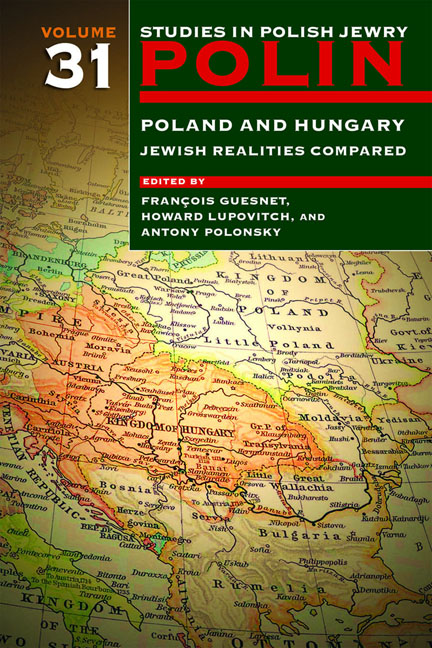Book contents
- Frontmatter
- Dedication
- Editors and Advisers
- Preface
- Polin
- Polin: Studies in Polish Jewry
- Contents
- Note on Place Names
- Note on Transliteration
- Part I POLAND AND HUNGARY: JEWISH REALITIES COMPARED
- JEWISH ACCULTURATION AND INTEGRATION
- JEWISH RELIGIOUS LIFE
- JEWS IN POPULAR CULTURE
- THE INTERWAR YEARS
- THE HOLOCAUST AND ITS AFTERMATH
- PERSONAL REFLECTIONS
- Part II NEW VIEWS
- Part III OBITUARIES
- Notes on the Contributors
- Index
‘Nicht Vor Dem Kind!’ Testimonies on the Yellow-Star Houses of Budapest
- Frontmatter
- Dedication
- Editors and Advisers
- Preface
- Polin
- Polin: Studies in Polish Jewry
- Contents
- Note on Place Names
- Note on Transliteration
- Part I POLAND AND HUNGARY: JEWISH REALITIES COMPARED
- JEWISH ACCULTURATION AND INTEGRATION
- JEWISH RELIGIOUS LIFE
- JEWS IN POPULAR CULTURE
- THE INTERWAR YEARS
- THE HOLOCAUST AND ITS AFTERMATH
- PERSONAL REFLECTIONS
- Part II NEW VIEWS
- Part III OBITUARIES
- Notes on the Contributors
- Index
Summary
IN 19 March [1944] was a Sunday, which is why we would have gone for a walk. The next day, my mother took me over to see Dr Halmi at the Hungarian–Italian Bank, where my father also worked… . I don't remember exactly what they discussed, but they did talk about the danger facing us. As a result of this conversation, it wasn't initially the feeling of humiliation that implanted itself in my conscience, but just the opposite: this conversation put an end to the humiliating feeling that my parents didn't take me seriously or discuss the most important issues with me. Until that point I knew, and had to know, that we were facing certain dangers. If from nowhere else, then from the arguments between my mother and Aunt Jolán. And there were lots of other signs earlier on too, except I don't remember them. It seems that all too often, I heard: Nicht vor dem Kind!
MIHÁLY VAJDA, ‘In the Yellow-Star House’On 27 JANUARY 2014 the Open Society Archives (OSA) in Budapest launched a Hungarian-language interactive website and a bilingual Facebook page dedicated to the history of Budapest's ‘yellow-star houses’ and the reception of this history. The yellow-star houses were residential buildings, distributed across the capital, into which Budapest's Jews were concentrated in preparation for their deportation. OSA used mapping technology and social media and invited people to share their stories, photographs, and documents about the houses and the families who lived in them. OSA further invited the public, public institutions, and several embassies to hold commemorations outside the former yellow-star houses on 21 June 2014, the seventieth anniversary of the forced mass relocation.
In this chapter I shall discuss the establishment of the yellow-star houses in 1944, the methodology of OSA's project, and the bitter political environment in which it took place and present the corpus of testimonies received by OSA as a unique collection of oral histories that sheds light not only on what life was like in a yellow-star house but also on how the Holocaust was generally not spoken about from the late 1940s until the mid-1980s, either in public or in private.
- Type
- Chapter
- Information
- Polin: Studies in Polish Jewry Volume 31Poland and Hungary: Jewish Realities Compared, pp. 455 - 470Publisher: Liverpool University PressPrint publication year: 2018



